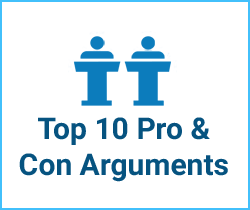Should Incarcerated People Be Counted as Residents of the Jurisdiction in which the Prison/Jail Is Located?
General Reference (not clearly pro or con)
Hansi Lo Wang, national correspondent for NPR, and Kumari Devarajan, producer for NPR’s Code Switch, in a Dec. 31, 2019 article, “‘Your Body Being Used’: Where Prisoners Who Can’t Vote Fill Voting Districts,” available at npr.org, stated:
“[I]f [Robert]Alexander and his more than 1,200 fellow prisoners are still incarcerated at Waupun Correctional Institution [in Wisconsin] next Census Day — April 1 — the Census Bureau will officially consider them residents of Waupun, Wis., for the 2020 national head count.
That’s because, since the first U.S. census in 1790, the federal government has included incarcerated people in the population counts of where they’re imprisoned. This technical detail of a little-known policy can have an outsized impact on prison towns across the U.S. for the next decade.
In many cases, rural, predominantly white towns see their population numbers boosted by population counts from prisons disproportionately made up of black and Latinx people.
In turn, states, which control how voting districts are drawn, and local governments can use those numbers to form districts filled predominantly with people who are locked behind bars and cannot vote in almost all states. Maine and Vermont are the exceptions.
Officials in some prison towns have come up with creative ways to avoid forming voting districts made up primarily of prisoners. But in many others, political lines are drawn around prisons in a way that critics deride as ‘prison gerrymandering.'”
Dec. 31, 2019
The U.S. Census Bureau stated in its Feb. 21, 2006 report “Tabulating Prisoners at Their ‘Permanent Home of Record’ Address”:
“Congress directed the U.S. Census Bureau to study tabulating prisoners at the address of their ‘permanent home of record,’ rather than at their place of incarceration… The following uncertainties and challenges were identified:
– There is no generally agreed-upon definition of the concept ‘permanent home of record.’
– Address information for prisoners would need to be collected either through individual enumeration procedures or through access to administrative records…
– It is unclear how the Census Bureau can satisfy its legal obligation to report the whole number of persons in each State for Apportionment purposes if it tabulates prisoners at an address other than where they are confined.
– The estimated cost is $250 million…
Counting prisoners at a ‘permanent home of record’ address, rather at their place of incarceration, would result in increased cost both to the decennial census program and to the Federal, State, and local correctional facilities that would be required to participate in data collection effort. Our study raises concerns that this change would result in decreased accuracy for a possibly large proportion of millions of individuals confined on Census day.
The completeness of the census count would be compromised for prisoners that cannot provide a valid address, and we have no method of determining how many individuals would fall into that category. Further, a fundamental shift for the enumeration of correctional facilities would likely have a negative impact on other Group Quarters [residential facilities such as student dormatories and nursing homes] enumerations.”
Feb. 21, 2006 - Tabulating Prisoners at Their 'Permanent Home of Record' Address
PRO (yes)
Pro
The US Census Bureau in a Feb. 8, 2018 publication, “Final 2020 Census Residence Criteria and Residence Situations,” available at federalregister.gov, stated:
“For the 2020 Census, the Census Bureau will retain the proposed residence situation guidance for correctional facilities (Sections C.13.e, C.15, and C.17.a). The practice of counting prisoners at the correctional facility is consistent with the concept of usual residence, as established by the Census Act of 1790. As noted in section A.1 of this document, “usual residence” is defined as the place where a person lives and sleeps most of the time, which is not always the same as their legal residence, voting residence, or where they prefer to be counted. Therefore, counting prisoners anywhere other than the facility would be less consistent with the concept of usual residence, since the majority of people in prisons live and sleep most of the time at the prison.
States are responsible for legislative redistricting. The Census Bureau works closely with the states and recognizes that some states have decided, or may decide in the future, to `move’ their prisoner population back to the prisoners’ pre-incarceration addresses for redistricting and other purposes. Therefore, following the 2020 Census, the Census Bureau plans to offer a product that states can request, in order to assist them in their goals of reallocating their own prisoner population counts. Any state that requests this product will be required to submit a data file (indicating where each prisoner was incarcerated on Census Day, as well as their pre-incarceration address) in a specified format. The Census Bureau will review the submitted file and, if it includes the necessary data, provide a product that contains supplemental information the state can use to construct alternative within-state tabulations for its own purposes. However, the Census Bureau will not use the state-provided data in this product to make any changes to the official decennial census counts.”
Feb. 8, 2018
Pro
Betty Little, New York State Senator (R), as quoted by Tim Henderson in a Jan. 2, 2019 article, “Counting Prison Inmates Differently Could Shift Political Power to Cities,” available at pewtrusts.org, stated:
“I don’t understand the logic of counting people where they aren’t, where they don’t live. Counting those who are incarcerated where they once were and may never be again isn’t fair to the communities that actually provide the local services, such as water, sewer, emergency responders, health care and courts.”
Jan. 2, 2019
CON (no)
Con
The New York Times Editorial Board, in an Apr. 11, 2021 article, “You’ve Heard about Gerrymandering. What Happens When It Involves Prisons?,” available at nytimes.com, stated:
“A healthy representative democracy needs an accurate picture of who lives where in order to allocate the proper number of lawmakers to represent their interests. It’s why the census is the first job the Constitution gives Congress.
Prison gerrymandering distorts this picture in two ways: by artificially inflating the population of places where prisons are, and artificially decreasing the population of the places where prisoners come from.
Add to that the constitutional principle of one person, one vote, which requires all legislative districts to be roughly the same size. If large groups of people are counted in the wrong place, the result is a government skewed in favor of some and against others.
When it comes to prisoners, the skew follows a clear pattern: Prisoners are disproportionately Black and brown people from urban areas, and prisons are disproportionately built in more rural areas. So counting people where they’re imprisoned takes political power away from racial minorities in cities and transfers it to whites in rural areas.
In one Rhode Island House district, for instance, prisoners account for nearly 16 percent of the population, even though only 4 percent of them are from that district.
In Juneau County, Wis., it’s even worse: Prisoners account for 80 percent of the entire population of one district.”
Apr. 11, 2021
Con
Aleks Kajstura, JD, Legal Director of the Prison Policy Initiative, as quoted by Hansi Lo Wang and Kumari Devarajan in a Dec. 31, 2019 article, “‘Your Body Being Used’: Where Prisoners Who Can’t Vote Fill Voting Districts,” available at npr.org, stated:
“What has changed is just the massive scale of incarceration in the U.S. What worked for the country in 1790 just doesn’t work anymore in terms of data methodology. Even up until the 1970s, the incarcerated population was low enough that it did not impact redistricting when people were counted in the wrong place…
This facility that they happen to be incarcerated on Census Day is in no way reflective of the reality of where they actually even live and sleep most of the time even by the Census Bureau’s own guidelines [because they could be transferred to another facility].”
Dec. 31, 2019
Con
Madeleine Susi, Campaign for Youth Justice Communications Fellow, in an Apr. 14, 2020 article, “Counting Incarcerated People on the 2020 Census,” available at cfyj.org, stated:
“While the census has always counted incarcerated people as residents of the location where they are serving their sentence, this decision has become more problematic as the prison population has risen. Counting incarcerated people as part of the population where the prison is located can exaggerate that area’s population and increase the political power of the residents there. Correctional facilities are increasingly located in areas that are geographically and demographically far removed from the communities to which most incarcerated people belong. leading to misleading conclusions about the size and growth of communities.
Because Black and Latinx populations are incarcerated at a much higher rate of Whites, this has led to tremendous implications for how these populations are reflected in the Census. The African-American subcommittee of the Census Bureau’s Race and Ethnicity Advisory Committee has made suggestions that the Census Bureau count prisoners as residents of their pre-incarceration addresses.
Not only does this dynamic influence political power, but it also often creates inaccurate population counts. After incarcerated people are counted for the census, the results are often not reflective of where these people actually live… On the other hand, other groups, such as students from boarding schools, are awarded different privileges and are still counted on the census at their home address despite not permanently living there. These issues culminate into a reality in which while prisoners are absent from their communities, they are being used as political leverage elsewhere.”
Apr. 14, 2020
Con
Julie A. Ebenstein, JD, Senior Staff Attorney at the ALCU’s Voting Rights Project, in a 2018 article, “The Geography of Mass Incarceration: Prison Gerrymandering and the Dilution of Prisoners’ Political Representation,” available in the Fordham Urban Law Journal, stated:
“Every ten years, the Census Bureau counts the entire United States population. Each individual is counted at his or her “usual residence,” the home where he or she lives or sleeps most of the time. Legislative seats are apportioned, and electoral district lines drawn, based on that Census count. For purposes of the Census, the approximately 2.2 million people in prison in the United States are counted as residents of the district in which they are incarcerated, not of their home prior to incarceration. In all but two states, individuals incarcerated for a felony conviction are also ineligible to vote. Consequently, they become non-voting “residents” of the district in which they are incarcerated, represented by a legislator over whom they have no electoral influence.
The practice of counting people who are incarcerated and ineligible to vote as residents of their prison cell inflates the population count in districts where prisons are located. It increases the voting strength of those districts’ other residents relative to the residents of neighboring districts, and dilutes the voting strength of prisoners’ home communities. At the same time, correctional facilities are not dispersed evenly throughout most states, but are often found in more rural, predominantly white areas, while people incarcerated in these facilities are disproportionately people of color from comparatively urban areas. Counting prisoners as residents of the district where they are incarcerated shifts political power from urban to more rural areas. The confluence of prisoners’ ineligibility to vote, an increase in the United States’ prison population in recent decades, and the treatment of people in prison as ‘residents’ of the district where they are incarcerated has skewed legislative apportionment and the distribution of political power. Counting people in prison as residents of their home prior to incarceration will begin to address this imbalance.”
2018


